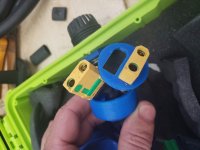Philtek
1 mW
- Joined
- Mar 22, 2015
- Messages
- 17
Last fall I finally put together this little outboard project I intend to use on my Hobie tandem island and small dinghies. The premise was simple: utilize my existing e-bike batteries to power me on the water. I wanted to also play around with creating youtube content for some of my projects. My video editing skills are rudimentary and still in development. I figure I have to start somewhere and why not start document what I am doing.
[youtube]TWHClLt30Bw[/youtube]
I have a few 52 volt batteries I use in my cargo bikes and have since adapted an echo chainsaw to run with the 52 batteries. I looked around what is available in the electric outboard market and all the brand name stuff like torqueedo is very costly for what you get. The battery systems tend to be locked down as well. I did come across some overseas sellers offering "Hangkai" branded outboards that claimed to run at higher voltages but they seem surprisingly noisy.
In the interest of getting the project in the water I harvested the outboard bracket from an old Chrysler two stroke outboard instead of trying to build one from scratch or buying one from overseas. I used a 1-1/8th aluminum pipe for the leg section and was able to use bike stem clamps and weld together my own mount for the motor. I used stem clamps again at the top of the outboard to mount the electronics enclosure as well as a handle bar to rotate the whole lot. I printed a PETG bushing of sorts to fit the 1-1/8th down tube into the outboard bracket. The bushing features a clam style friction adjustment bolt that I can use to dial in the rotational friction of the down tube in the bushing. I'd say this worked quite well.
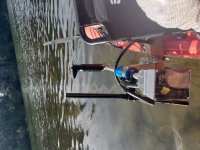
Motor: I liked the submerged motor nacelle design as you can benefit from direct drive efficiency while practically eliminating noise and motor cooling issues. In searching for submersible motors I came across the flipsky 65151 motor and liked what I saw. Rated to run underwater at 6kw, 6-20s (84v) at 100kV, it seemed like the perfect motor to use in a small outboard platform.
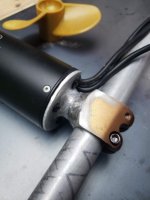

Controller: I ended up using a VESC 4.2 for the controller and housed it inside an aluminum enclosure. These are rated for use at 60v and claim to handle 50 amps if cooled sufficiently. Currently, the control scheme consists of a grin aux pot mounted on a handlebar (thanks for the 1-1/8th down tube!) The throttle is configured in a 20/10/60 split for reverse, dead band, and forward. The safety disconnect for now is unplugging the battery. I had a dead man style teather switch mounted on the bar but since the VESC 4.2 does not support a kill switch function I decided to not worry about the switch until I upgraded controllers to the VESC 6.6 or better. I have a VESC6.6 ready to be fitted up. I should be able to sustain higher currents for longer before over heating and the bluetooth logging while connecting to the VESC app will be great. No more laptop at the lake! Thankfully the laptop has yet to be in the lake and I'd like to keep it that way.
Battery: With the help of a friend a little while back I built a couple 52v 17ah packs using Sanyo GA cells. These packs use a 50 amp BMS and the plan for this project is to run them in parallel if needed. I used a pelican style case made my Nanuk to water proof the batteries and since I couldn't quite find a power gland solution that checked all the boxes (good current, fully sealed, robust, locking, and affordable) I put together my own solution using MT90 connectors, a threaded cable gland, and some 3D printed parts. The system as designed allows me to run one or two batteries in the case as the motor cable plug will accept either one or two MT90 connectors. The gland can be hooked/unhooked in a few seconds and has proven to be waterproof. The gland manages to easily hold the battery up dangling by the case. When the pack and motor are disconnected, I can intall a plug cap onto the gland and seal it during transport. Neon green case becuase why not! and if I somehow end up capsized or in the drink I might be able to spot the thing in the water... assuming it floats. Turns out with the two batteries loaded in case the whole lot is close to neutrally buoyant as tested in my pond. At least it seems to hold water out ok for short periods.

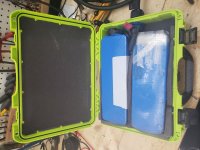
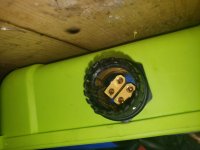
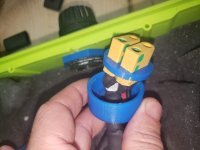
Propellers: I have been 3D printing propellers based on designs I found online. I have been playing with the blade size and pitch and have had some fun dialing it in to be able to reach peak power with the current set up. What I thought was a reasonable size/pitch propeller ended up being way too big and loaded the motor too heavily. I don't remember the exact figures now but I remember reaching 60 phase amps while using only 15 or so battery amps. First this I did was reduce the pitch on the propellers as much as I could before I'd need to start printing with supports. Then I shrunk the diameter of the blades about 3 or 4 times before being able to balance my phase and battery amps around 50 amps. I fiddled around with some static thrust measurements, but I'd like to look a bit more closely at performance using a few different pitches. The new VESC will allow better data logging. Propeller STL files can be found here
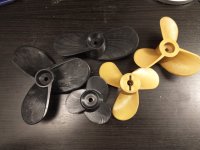 .
.
Things to come this spring:
VESC6 install: I'm hoping to cram it into the same enclosure but it will be tight. I might need to desolder the caps and rotate them so they stand vertically. I can now utilize the dead man switch functionality.
Datalogging: The VESC6 will work with bluetooth and I should be able to log data and change motor parameters on the fly without the need for laptop
Force logging?: A strain gauge fitted to the outboard leg could record real time thrust data, not just static thust.
Prop comparison: Even if I don't get around to installing a strain gauge, I hope with the data from the controller and the static thrust data as well as speed, I can characterize how prop size and pitch play out for this vessel platform. I can at the very least compare power consumption vs speed at various RPM for a few different propellers.
[youtube]TWHClLt30Bw[/youtube]
I have a few 52 volt batteries I use in my cargo bikes and have since adapted an echo chainsaw to run with the 52 batteries. I looked around what is available in the electric outboard market and all the brand name stuff like torqueedo is very costly for what you get. The battery systems tend to be locked down as well. I did come across some overseas sellers offering "Hangkai" branded outboards that claimed to run at higher voltages but they seem surprisingly noisy.
In the interest of getting the project in the water I harvested the outboard bracket from an old Chrysler two stroke outboard instead of trying to build one from scratch or buying one from overseas. I used a 1-1/8th aluminum pipe for the leg section and was able to use bike stem clamps and weld together my own mount for the motor. I used stem clamps again at the top of the outboard to mount the electronics enclosure as well as a handle bar to rotate the whole lot. I printed a PETG bushing of sorts to fit the 1-1/8th down tube into the outboard bracket. The bushing features a clam style friction adjustment bolt that I can use to dial in the rotational friction of the down tube in the bushing. I'd say this worked quite well.

Motor: I liked the submerged motor nacelle design as you can benefit from direct drive efficiency while practically eliminating noise and motor cooling issues. In searching for submersible motors I came across the flipsky 65151 motor and liked what I saw. Rated to run underwater at 6kw, 6-20s (84v) at 100kV, it seemed like the perfect motor to use in a small outboard platform.


Controller: I ended up using a VESC 4.2 for the controller and housed it inside an aluminum enclosure. These are rated for use at 60v and claim to handle 50 amps if cooled sufficiently. Currently, the control scheme consists of a grin aux pot mounted on a handlebar (thanks for the 1-1/8th down tube!) The throttle is configured in a 20/10/60 split for reverse, dead band, and forward. The safety disconnect for now is unplugging the battery. I had a dead man style teather switch mounted on the bar but since the VESC 4.2 does not support a kill switch function I decided to not worry about the switch until I upgraded controllers to the VESC 6.6 or better. I have a VESC6.6 ready to be fitted up. I should be able to sustain higher currents for longer before over heating and the bluetooth logging while connecting to the VESC app will be great. No more laptop at the lake! Thankfully the laptop has yet to be in the lake and I'd like to keep it that way.
Battery: With the help of a friend a little while back I built a couple 52v 17ah packs using Sanyo GA cells. These packs use a 50 amp BMS and the plan for this project is to run them in parallel if needed. I used a pelican style case made my Nanuk to water proof the batteries and since I couldn't quite find a power gland solution that checked all the boxes (good current, fully sealed, robust, locking, and affordable) I put together my own solution using MT90 connectors, a threaded cable gland, and some 3D printed parts. The system as designed allows me to run one or two batteries in the case as the motor cable plug will accept either one or two MT90 connectors. The gland can be hooked/unhooked in a few seconds and has proven to be waterproof. The gland manages to easily hold the battery up dangling by the case. When the pack and motor are disconnected, I can intall a plug cap onto the gland and seal it during transport. Neon green case becuase why not! and if I somehow end up capsized or in the drink I might be able to spot the thing in the water... assuming it floats. Turns out with the two batteries loaded in case the whole lot is close to neutrally buoyant as tested in my pond. At least it seems to hold water out ok for short periods.




Propellers: I have been 3D printing propellers based on designs I found online. I have been playing with the blade size and pitch and have had some fun dialing it in to be able to reach peak power with the current set up. What I thought was a reasonable size/pitch propeller ended up being way too big and loaded the motor too heavily. I don't remember the exact figures now but I remember reaching 60 phase amps while using only 15 or so battery amps. First this I did was reduce the pitch on the propellers as much as I could before I'd need to start printing with supports. Then I shrunk the diameter of the blades about 3 or 4 times before being able to balance my phase and battery amps around 50 amps. I fiddled around with some static thrust measurements, but I'd like to look a bit more closely at performance using a few different pitches. The new VESC will allow better data logging. Propeller STL files can be found here
 .
.Things to come this spring:
VESC6 install: I'm hoping to cram it into the same enclosure but it will be tight. I might need to desolder the caps and rotate them so they stand vertically. I can now utilize the dead man switch functionality.
Datalogging: The VESC6 will work with bluetooth and I should be able to log data and change motor parameters on the fly without the need for laptop
Force logging?: A strain gauge fitted to the outboard leg could record real time thrust data, not just static thust.
Prop comparison: Even if I don't get around to installing a strain gauge, I hope with the data from the controller and the static thrust data as well as speed, I can characterize how prop size and pitch play out for this vessel platform. I can at the very least compare power consumption vs speed at various RPM for a few different propellers.


